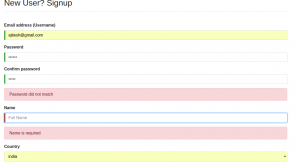Top 5 Blockchain Technology Online Courses

This is a list of top 5 blockchain technology courses which can be used for training yourself online. My Favorite one is Bitcoin and Cryptocurrency technologies course on Coursera.org from Arvind Narayana, Assistant professor in Princeton University. All these courses are well suited for beginners. Thus, if you are planning for reskilling yourself in Blockchain technologies, go ahead and try one of these courses. Please feel free to suggest one or more courses if I missed to mention them. Blockchain for Business: An Introduction to Hyperledger Technologies A primer to blockchain and distributed ledger technologies. One can learn how to start building permissioned Blockchain applications for their enterprises/business. Following are some of …
Angular – Best Practices to Capture User Inputs
This blog represents a list of recommendations for capturing user inputs from a form in an Angular app. One should make use of template reference variable instead of the $event object to refer to the input element in order to capture user inputs from forms. Following represents the usage of template reference variable. The following represents usage of $event object (not recommended): When using the template reference variable, the “value” should be passed rather than passing elements. The following represents usage of passing by value: Keep template statements simple. The following represents two statements on keyup event, one to pass the value and second to clear the field. In case …
Top 13 Online Platforms providing IT Courses

In this age when everyone is talking about reskilling and upskilling, online platforms such as coursera.org, Khan Academy has taken a strong foothold in providing online education to knowledge seekers worldwide. The following is a list of some of the most popular online platforms or websites/web apps which can be used for self-paced learning or training or reskilling yourself in different technologies including AI (machine learning), Web and Mobile programming languages and related frameworks, Blockchain, Virtual Reality etc. Please feel free to suggest one or more online platforms which I did not mention. Coursera – https://www.coursera.org/ Khan Academy – https://www.khanacademy.org/ Codecademy – https://www.codecademy.com/ edX – https://www.edx.org/ Udacity – https://www.udacity.com/ Udemy …
Go – How to Create a Package in Go Language
This blog represents code samples and related concepts on how to create a package or library using GO programming language. Create a HelloWorld Package Save the following code within some file such as hello.go within some package folder such as helloworld within folder $GOPATH/src. Create the package using command such as go install helloworld. Alternatively, go inside the folder helloworld and execute the command, go install. This would lead to creation of *.a file within $GOPATH/pkg folder. Note that command such as go build can be used to compile and check if there are any errors. Pay attention to some of the following: The methods to be exported MUST start …
Blockchain Usecase – Freelancer to Benefit Lot More
Blockchain has been revolutionizing different kind of businesses including financial, banking, supply chain management etc. Given the very nature of this Blockchain technology, it is also going to disrupt freelance industry benefiting mostly the freelancers. And, this blockchain network implementation most probably looks to be a public blockchain which can be implemented using platform such as ethereum. Following are some of the platforms which are already working on this idea of using Blockchain for freelancing: Ethlance.com: Ethlance is a first of its kind platform for connecting freelancers and developers. It has its database running completely on Ethereum public blockchain and front-end source files distributed on IPFS, that means it’s completely …
Angular Error – No directive with exportAs set to ngForm
While running unit tests for the Angular app (Angular 2/Angular 4), I came across the error such as following: Failed: Template parse error: There is no directive with “exportAs” set to “ngForm” Here is the screenshot of the error. Note that the form referenced in this blog is a template-driven form. This blog represents the resolution of above error. Template and Unit Test Code Before the Fix The template code defined the template reference variable, #signupForm, for form element as shown in the following code. Following was the unit test code prior fix/resolution: Unit Test Code after the Fix/Resolution Pay attention to the inclusion of FormsModule in imports array. In …
Angular – Use Template Reference Variable for User Inputs
This blog represents tips and code sample for using Template reference variable for capturing user inputs in an Angular form. Template code for Template Reference Variable The following code represents the template file, app.component.html. Component code for Template Reference Variable The following represents the component code, app.component.ts: In case you are developing web apps using Spring and Angular, check out my book, Building web apps with Spring 5 and Angular. Grab your ebook today and get started.
Angular – Signup Form Code Sample

This blog represents code samples and related concepts which can be used to create a Signup form in Angular (Angular 2/Angular 4).In order to create signup form, following code is required to be written: Model class for Signup Template (UI) code for Signup Component code for handling Signup Form Style code for visually handling input validation Module code that includes the SignupComponent This is how the screenshot of the Signup form looks like: Following are different files which may need to be created to manage signup module: signup.ts (Model class) signup.component.ts (Component) signup.component.html (Template) signup.component.css (CSS styles that are used in template) app.module.ts or signup.module.ts (in case, signup is a …
Top 3 Javascript Frameworks for 2018 – Angular, ReactJS, VueJS
From trends data retrieved from sources such as Google, Stackoverflow etc., it is seeming as if the javascript framework of choice for developing your next web app has to be in one of the following. As of today, these are top three javascript frameworks trending on Google, Stackoverflow etc. Angular/AngularJS ReactJS VueJS Google Web Search Trends – Angular, ReactJS, VueJS StackOverflow Q&A Trends – Angular, ReactJS, VueJS
How to Upgrade from Angular 2 to Angular 5 Apps
This blog represents steps required to upgrade or update or migrate existing Angular 2 apps to Angular 5 apps. Greater details can be found on Angular 5 announcement blog. Upgrade/Update Preparation from Angular 2 to Angular 5 Apps The following are some of the activities which are recommended before the update/upgrade is done: Ensure that extends with lifecycle events are replaced with implements <lifecycle event> In case animation is used in the app, BrowserAnimationsModule from @angular/platform-browser/animations needs to be imported in NgModule OpaqueTokens should be replaced with InjectionTokens Rename the template tags to ng-template tag Update package.json file appropriately to update dependencies and devDependencies Update Package.json file for Dependencies/DevDependencies It is important to update package.json file for upgrading angular apps using Angular 4 …
Oct 2017 – Angular Vs ReactJS – Which one was Popular?
This page represents the popularity of Angular vs ReactJS in October 2017 from different sources including Google Trends etc. It is evident that Angular is seeing greater adoption followed by ReactJS. It is also interesting to note from search keywords trends that Vue.js. Another key observation is the interview questions which developers are seeking in relation with Angular. Google Trends – Angular vs ReactJS Google Popular Search Keywords – Angular vs ReactJS
Angular – Two Ways to Capture User Inputs
This blog represents concepts and code samples which can be used for capturing user inputs from the form in an Angular app using following techniques: Using $event object Using template reference variable Using $event in template statement The following depicts the code which needs to be used in template code. Make a note of The following depicts the code which needs to be used in the component code. Using Template Reference Variables The following depicts the code which needs to be used in template code. Make a note of usage of # (hash) with the template reference variable, email. The reference variable, #email, represents the input element. The following depicts …
Angular Unit Testing Interview Questions – Set 2
This quiz provides basic questions in relation to Angular unit testing. The following are some of the concepts which are covered in this quiz. Angular unit testing fundamentals Angular testing utilities – TestBed [wp_quiz id=”5464″]
Angular Bootstrap Responsive Template – Code Sample
Following code can be placed in the index.html file to adopt Bootstrap 4.* with Angular App (Angular 2 or Angular 4) after you have created an Angular app using Angular CLI commands such as “ng new projectName” which is used for creating a new Angular project. Pay attention to some of the following: Responsiveness is achieved using following code: Bootstrap CSS library is included within head tag. Bootstrap Javascript (optional) is included as part of Body tag In case you are developing web apps using Spring and Angular, check out my book, Building web apps with Spring 5 and Angular. Grab your ebook today and get started.
Angular – How to Handle Password Confirmation Logic

This blog represents code samples and related concepts on how to handle password confirmation logic in an Angular app (Angular 2/Angular 4). Note that the code samples make use of template-driven forms and uses [(ngModel)] for two-way data bindings. Following are key aspects discussed in this blog: Template code for handling password confirmation logic Component code for handling password confirmation logic Signup model code In this blog, it is considered that password confirmation logic is a key part of signup form. Thus, a model name Signup is used. However, the logic can also be used in update password form. Following screenshot represents password confirmation UI related with the code given …
How to Upgrade Angular 4 to Angular 5 Apps
This blog represents steps required to upgrade or update or migrate existing Angular 4 apps to Angular 5 apps. Greater details can be found on Angular 5 announcement blog. I must tell you that upgrading from angular 4 to angular 5 is not like the one represented below (from AngularJS to Angular 2.* and later versions). In this post, you will learn about some of the following: Preparation for upgrading from Angular 4 to Angular 5 Running the upgrade activity Post-upgrade activities Testing the Angular 5 App Upgrade/Update Preparation from Angular 4 to Angular 5 Apps The following are some of the activities which are recommended before the update/upgrade is done: Rename …
I found it very helpful. However the differences are not too understandable for me